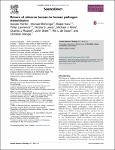Drivers of airborne human-to-human pathogen transmission
Herfst, Sander
Böhringer, Michael
Karo, Basel
Lawrence, Philip
Lewis, Nicola S.
Mina, Michael J.
Russell, Charles J.
Steel, John
Swart, Rik L. de
Menge, Christian
Airborne pathogens - either transmitted via aerosol or droplets - include a wide variety of highly infectious and dangerous microbes such as variola virus, measles virus, influenza A viruses, Mycobacterium tuberculosis, Streptococcus pneumoniae, and Bordetella pertussis. Emerging zoonotic pathogens, for example, MERS coronavirus, avian influenza viruses, Coxiella, and Francisella, would have pandemic potential were they to acquire efficient human-to-human transmissibility. Here, we synthesize insights from microbiological, medical, social, and economic sciences to provide known mechanisms of aerosolized transmissibility and identify knowledge gaps that limit emergency preparedness plans. In particular, we propose a framework of drivers facilitating human-to-human transmission with the airspace between individuals as an intermediate stage. The model is expected to enhance identification and risk assessment of novel pathogens.
Files in this item
No license information

